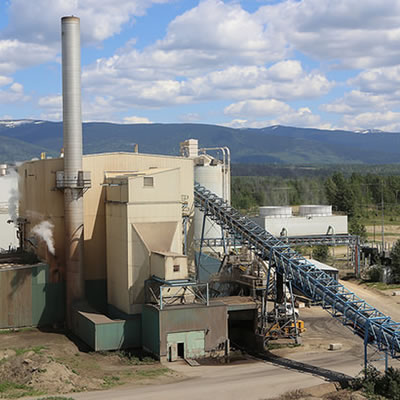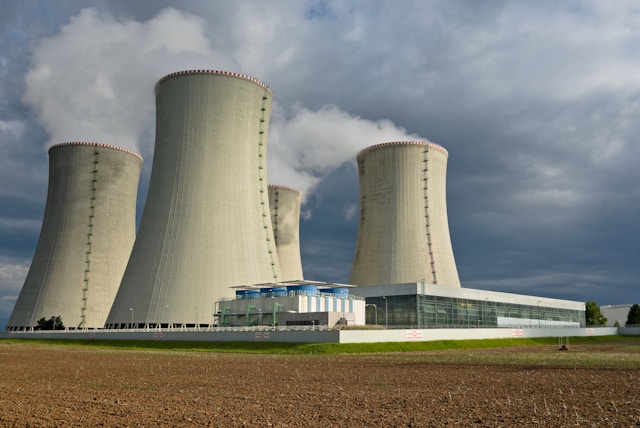Conifex Timber launches biomass power plant

Conifex Timber's biomass power plant in Mackenzie, B.C.—the plant uses sawmill residuals to produce clean energy for over 20,000 homes on the BC Hydro
Conifex Timber's biomass power plant in Mackenzie, B.C.—the plant uses sawmill residuals to produce clean energy for over 20,000 homes on the BC Hydro power grid. — Photo courtesy Conifex Timber Inc.
Conifex Timber Inc. recently commissioned a 230-GWh (gigawatt hours) biomass power plant in Mackenzie, in the northern interior of British Columbia. The plant uses sawmill residuals to produce clean energy for over 20,000 homes on the BC Hydro power grid.
This is how the power plant works, said vice-president corporate development Sandy Ferguson: Fuel in the form of sawmill residuals is delivered to two different fuel receiving areas. First, the wet portion, known as hog fuel (the outside portion of the log, including the bark) is delivered by truck to the receiving area. The raw feed stock is transferred to a processing facility where large material (over three inches in diameter), as well as metals and rocks, are screened out. “The remaining material is run through a hogger, where it is consistently sized,” Ferguson said. “Fuel is then transferred to the fuel shed, a covered storage area the size of a football stadium, that contains between seven and 10 days of fuel.”
The fuel is divided into four zones. Fuel with a high moisture content is delivered to four over-pile reclaimers, which burn it in the fluidized bed portion of the boiler. “A second fuel supply, the dry fuel, is made up of kiln-dried shavings and planer chips from the sawmill,” Ferguson said. “They are delivered to a processing area where they are reduced in size, transferred to a hammer mill, pulverized and then stored in silos for two to three days. Then they are burned in two large cyclonic burners in the boiler area.” Ferguson said the two fuel systems ensure that the plant is maintaining the optimum fuel mix, with consistent moisture content that ensures constant steaming rates and maximum efficiency.
The power plant's boiler house contains a 280,000-pound-per-hour fluidized bed boiler and two cyclonic burners. Air emissions are managed with an electrostatic precipitator and stack. The boiler produces steam that travels through the piping to a turbine generator, which can produce 36 megawatts of renewable electric power. The electricity is conducted through large feeders to the power substation and exported to the BC Hydro grid.
Preliminary construction work on the plant took place between August and November 2012. After project financing was completed, construction resumed in September 2013. The plant was largely completed in mid-October 2014 and commissioned in April 2015 with a 72-hour test run. “Given that Conifex is a dedicated sawmill company, when the opportunity to build and operate a biomass power plant was identified, we knew we needed partners with expertise in power generation and project development to help us,” Ferguson said.
The company partnered with two B.C. engineering firms, Clean Energy Consulting Inc. and Spectrum Energy, on an engineer, procure, construct and manage (EPCM) contracting arrangement. JB Driver Projects Inc. was the lead construction contractor. Ferguson said the construction project faced a number of challenges. “The biggest challenge was integrating the existing assets and new equipment,” she said. Of the 18 parts of the plant, four were existing that Conifex used as is/where is; seven were existing assets the company upgraded; and seven were new components.
“For example, the ABB boiler that had been used was still in good condition and with some refurbishment we were able to repurpose it,” Ferguson said. “We wanted the most efficient generation set and purchased a new Dresser Rand turbine.”
Although Conifex expected the main risk to come from the repurposed equipment, it had an equipment failure in one of the new elements in mid-October 2014 after most of the construction had been completed. “Fortunately, it was backed by the manufacturer's warranty,” Ferguson said. “But it delayed our commissioning schedule by six months as we fixed the problem.” The benefit of the plant to Conifex is that it disposes of 172,000 tons of sawmill residuals. “In the past, they were considered a waste byproduct,” Ferguson said. “Now, however, they are recognized as valuable fuel.”
Ferguson said the plant contributes to Conifex's stability and growth by adding revenue to the company's top line and a good return to shareholders. “Because we have a predictable 20-year electricity purchase agreement with BC Hydro that is paid in Canadian dollars, it removes the currency risk we experience in the lumber sector where our products are sold in U.S. dollars,” she said. “And it evens out the volatility that is common in the cyclical lumber sector.”
Conifex Timber Inc.
Founded in 2008, Conifex Timber Inc. is a publicly traded forestry, sawmilling and power generation company that operates in the Northern Interior of British Columbia, with its head office in Vancouver.
The company manufactures structural grade spruce-pine-fir dimension lumber and produces renewable energy from its sawmill residuals.
The company's first acquisition was an idled sawmill at Fort St. James, which was followed by its purchase of the Mackenzie operation. Here, the company restarted one of the idled sawmills and built a 36-megawatt biomass power plant.
As of the end of 2014, over 88 per cent of the company's lumber products were exported. The company's customers are concentrated in the construction industry in the U.S. (51 per cent), Japan (nine per cent) and the remanufacturing market in China (28 per cent).
Founded in 2008, Conifex Timber Inc. is a publicly traded forestry, sawmilling and power generation company that operates in the Northern Interior of British Columbia, with its head office in Vancouver.
The company manufactures structural grade spruce-pine-fir dimension lumber and produces renewable energy from its sawmill residuals.
The company's first acquisition was an idled sawmill at Fort St. James, which was followed by its purchase of the Mackenzie operation. Here, the company restarted one of the idled sawmills and built a 36-megawatt biomass power plant.
As of the end of 2014, over 88 per cent of the company's lumber products were exported. The company's customers are concentrated in the construction industry in the U.S. (51 per cent), Japan (nine per cent) and the remanufacturing market in China (28 per cent).



